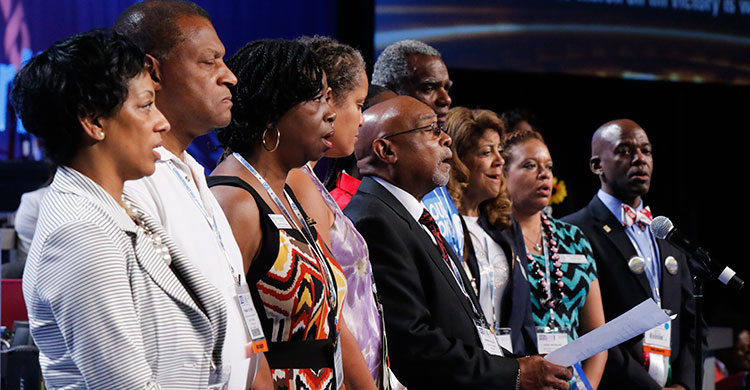
The National Education Association opened its Annual Meeting and Representative Assembly today by honoring the victims of the shooting rampage in Charleston, SC, and by recommitting its nearly three million members to confronting racism in our country.
“As the nation mourns and continues to grapple with the scourge of institutional racism, we thought it fitting that we pay tribute to the nine people who were murdered at Mother Emanuel AME Church on June 17th in Charleston, SC,” said NEA President Lily Eskelsen García. “To truly honor their lives and to ensure we continue to strive for the kind of world we want to live in, we must not forget their names.”
Members from the NEA Board of Directors then read the names of each victim as well as the contributions they made to their church and communities and the loved ones they left behind.
Following the tribute, Eskelsen García asked delegates to begin the meeting by “remembering that to ensure that our members and the students they serve have the opportunity to live and grow in a just and fair world, we must be willing to take risks, have tough debate and make difficult and challenging decisions.”
Delegates took up that charge during their first business session, unanimously passing a measure to redouble their efforts to fight against institutional racism. The delegates agreed that NEA members “acknowledge the existence in our country of institutional racism – the societal patterns that have the net effect of imposing oppressive conditions and denying rights, opportunity, and equality based upon race [and that] this inequity manifests itself in our schools and in the conditions our students face in their communities.”
To tackle institutional racism, NEA will spotlight systemic patterns of inequity – racism and educational injustice – that impact students and take action to enhance access and opportunity for students.
“I am a product of the 1960s and 70s, when we demonstrated with sit-ins, walk-outs, and marches for civil rights and women’s rights,” said NEA Executive Committee Member Joyce Powell, who spoke to the motion. “Much progress was made as white Americans stood side by side with black Americans, marched side by side, some lost their lives side by side, all because they wanted a better life for those who were being oppressed.”
The fact that so many decades later, people are still being killed because of the color of their skin is intolerable, Powell said, and that is the collective responsibility of NEA members to “address the tone of our country and the atrocities targeted at our brothers and sisters.”
“Our students and our communities must know that educators will use our collective voice to demand changes to policies, programs, and practices that condone or ignore unequal treatment. Our students must know that we want them to be safe. The NEA must lead our nation through this difficult time.”








